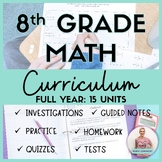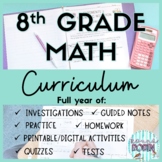Comparing Functions Guided Notes Practice Homework 8th Grade Math Worksheets
- Zip
- Google Apps™
- Microsoft OneDrive

What educators are saying
Also included in
- Are you looking for an entire 8th-grade math Curriculum with warm-ups, guided notes, practice worksheets, homework, and editable assessments? Look no further than this 8th-grade math GROWING curriculum full-year bundle. The following 8th-grade Math Curriculum is wholly aligned with Common Core StPrice $180.00Original Price $225.00Save $45.00
- Are you teaching Functions to your 8th-grade math students? Look no further than this complete Functions Unit Bundle. Topics include Identifying and Representing Functions, Describing Functions, Comparing Functions, and Analyzing Graphs. This Functions Unit Bundle includes Investigations, Guided NotPrice $17.60Original Price $22.00Save $4.40
- Are you looking for an entire 8th Grade Math Curriculum with guided notes, activities, AND editable assessments? Look no further than this 8th-grade math GROWING curriculum full year bundle. The following 8th-grade Math Curriculum is wholly aligned with Common Core State Standards for 8th grade iPrice $292.80Original Price $366.00Save $73.20
Description
Teach your middle school math or Algebra students about Comparing Functions. Students will learn how to compare functions from tables, graphs, descriptions, and equations. Students will also determine the rate of change and y-intercepts. These guided notes include investigation and practice worksheets which are perfect for a binder or can be reduced in size to fit into an interactive notebook.
✅This resource is perfect for Distance Learning (zero prep) or in the classroom. It can be used with Google™ or Microsoft™. You will receive a pdf with the printables, a link to the google slides, a PowerPoint version, and an answer key.
You must have a free Google™ account to access the Google™ slides.
⭐ These worksheets can be used digitally or in-person with the provided pdf handouts included.⭐
✅ 10 pages plus answer keys of notes and practice problems include:
- Optional Do Now/Warm Up
- Guided Notes with practice problems to do together in class and several "your turn" problems for students to do on their own so you can check their understanding before you assign the homework.
- 7 practice problems include a review of functions and exponents that can be used as in-class work, homework, or as group work + a challenge word problem question.
✅ Plenty of room for your students to write down their answers and show all of their work!
This is my third lesson in Unit 6: Functions
You may also like:
Don't forget to leave a review to earn credit towards future resources at no extra cost to you!
Let's be social!








